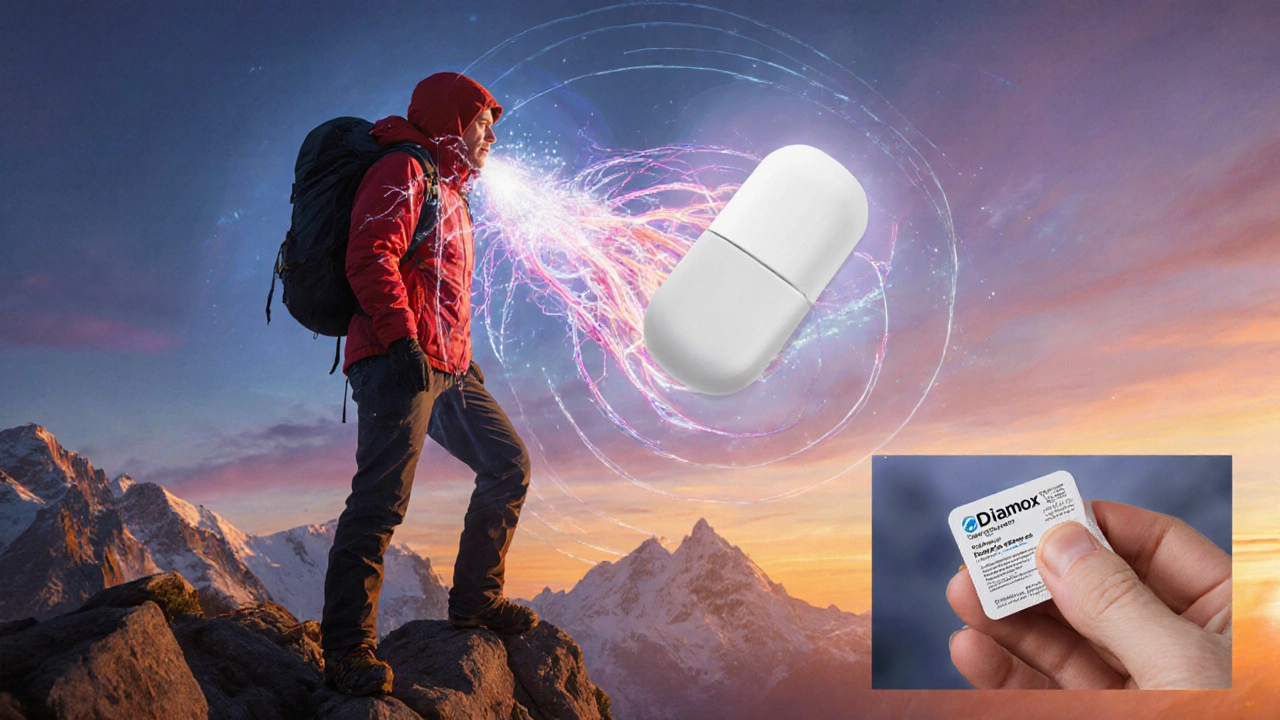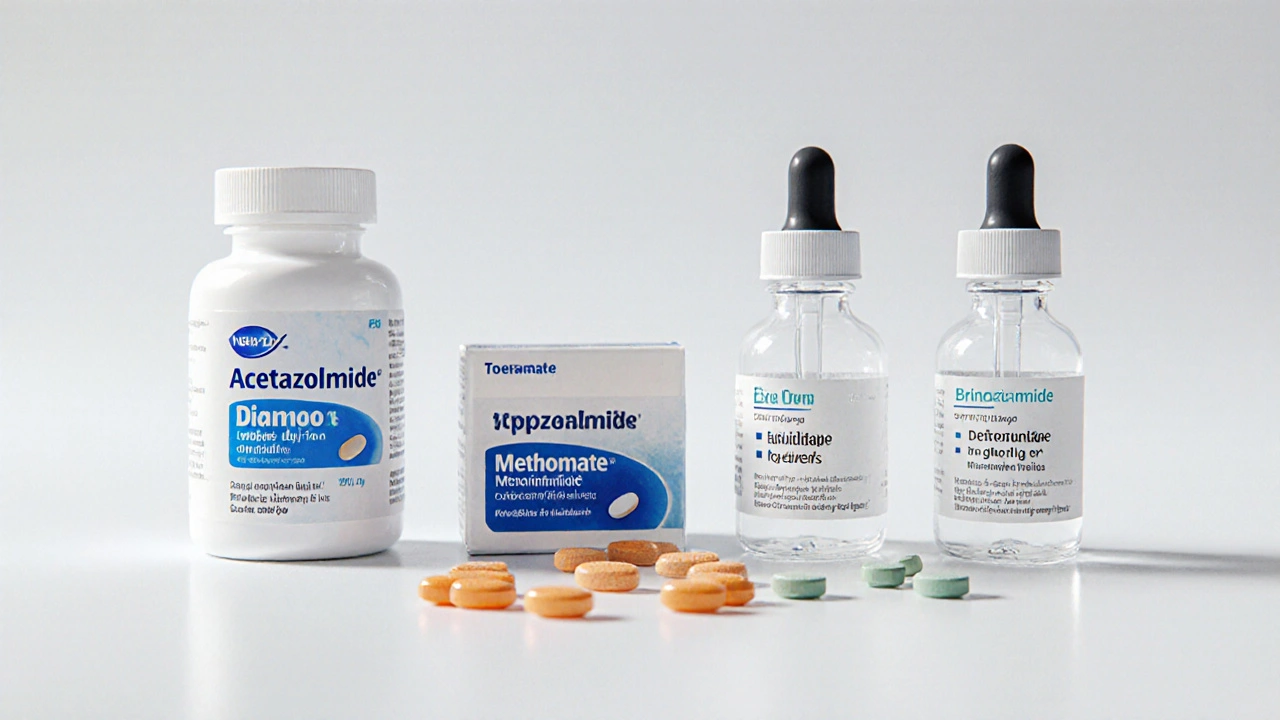Diamox vs Alternatives: Drug Comparison Tool
| Attribute | Diamox (Acetazolamide) |
Topiramate | Methazolamide | Dorzolamide (Drop) |
Brinzolamide (Drop) |
|---|---|---|---|---|---|
| Primary Indications | Altitude sickness, glaucoma, epilepsy, idiopathic intracranial hypertension | Altitude prophylaxis, epilepsy, migraine prevention | Glaucoma (especially sulfa-allergic patients) | Chronic open-angle glaucoma, ocular hypertension | Chronic open-angle glaucoma, ocular hypertension |
| Typical Dosage | 125-250 mg PO 2-4 × daily (acute); 250-500 mg PO daily for chronic | 25-100 mg PO daily (titrated) | 50-150 mg PO daily | 2 drops/eye BID | 1 drop/eye BID |
| Onset of Action | 30-60 min (altitude); 2-3 days (IOP) | 3-5 days (prophylaxis) | 2-3 days (IOP) | Within 1 hour (IOP) | Within 1 hour (IOP) |
| Duration of Effect | 6-12 hours (systemic) | 24 hours (once-daily) | 8-12 hours | 12 hours (local) | 12 hours (local) |
| Common Side Effects | Paresthesia, metallic taste, tinnitus, diuresis | Paresthesia, weight loss, cognitive fog | Similar to Diamox but milder | Burning, stinging, bitter taste | Transient blur, bitter taste |
| Key Contraindications | Sulfa allergy, severe hepatic disease, adrenal insufficiency | Kidney stones, metabolic acidosis | Sulfa allergy (less common), severe renal impairment | Corneal epithelial defects, hypersensitivity | Corneal epithelial defects, hypersensitivity |
Recommended Drug Based on Your Selection
Select your use case and patient profile to see a personalized recommendation.
Side Effects Summary
Key Takeaways
- Diamox remains the go‑to drug for rapid altitude‑sickness relief, but newer agents like topiramate offer oral convenience for prophylaxis.
- For chronic glaucoma, dorzolamide and brinzolamide provide similar intra‑ocular pressure control with fewer systemic side effects.
- Methazolamide is a solid middle‑ground for patients who can’t tolerate sulfonamide allergies associated with Diamox.
- When choosing an alternative, consider onset speed, dosing frequency, renal function, and specific contraindications.
- Always review drug‑drug interactions-especially with diuretics, anticonvulsants, and carbonic anhydrase‑inhibiting eye drops.
When evaluating Diamox (Acetazolamide), doctors balance its fast action against a handful of side‑effects. The drug belongs to the carbonic anhydrase inhibitor class, which works by reducing fluid production in the eye, kidneys, and brain. Below we break down how Diamox compares with the most common alternatives across key uses like altitude sickness, glaucoma, epilepsy, and fluid retention.
How Diamox Works
Acetazolamide blocks the enzyme carbonic anhydrase, leading to decreased bicarbonate reabsorption in the proximal tubule. The result is a mild metabolic acidosis that triggers increased ventilation-a lifesaver at high altitude. In the eye, the same enzyme inhibition lowers aqueous humor production, helping control intra‑ocular pressure (IOP). Because it works systemically, Diamox can also be useful in certain seizure disorders and idiopathic intracranial hypertension.

Top Alternatives at a Glance
Below are the primary drugs most people encounter when looking for a substitute:
- Topiramate - an anticonvulsant with carbonic anhydrase‑inhibiting properties, often prescribed for altitude‑prophylaxis.
- Methazolamide - a non‑sulfonamide carbonic anhydrase inhibitor used mainly for glaucoma.
- Dorzolamide - a topical eye drop delivering the same enzyme block directly to the eye.
- Brinzolamide - another topical option, often combined with a prostaglandin analog.
Side‑Effect Profiles
Systemic agents (Diamox, Topiramate, Methazolamide) share some overlap-nausea, paresthesia, and altered taste are common. Topical drops (Dorzolamide, Brinzolamide) stay largely out of the bloodstream, so they tend to cause ocular irritation rather than systemic upset. Here’s a quick snapshot:
| Attribute | Diamox (Acetazolamide) | Topiramate | Methazolamide | Dorzolamide (Drop) | Brinzolamide (Drop) |
|---|---|---|---|---|---|
| Primary Indications | Altitude sickness, glaucoma, epilepsy, idiopathic intracranial hypertension | Altitude prophylaxis, epilepsy, migraine prevention | Glaucoma (especially sulfa‑allergic patients) | Chronic open‑angle glaucoma, ocular hypertension | Chronic open‑angle glaucoma, ocular hypertension |
| Typical Dosage | 125‑250mg PO 2‑4×daily (acute); 250‑500mg PO daily for chronic | 25‑100mg PO daily (titrated) | 50‑150mg PO daily | 2drops/eye BID | 1drop/eye BID |
| Onset of Action | 30‑60min (altitude); 2‑3days (IOP) | 3‑5days (prophylaxis) | 2‑3days (IOP) | Within 1hour (IOP) | Within 1hour (IOP) |
| Duration of Effect | 6‑12hours (systemic) | 24hours (once‑daily) | 8‑12hours | 12hours (local) | 12hours (local) |
| Common Side Effects | Paresthesia, metallic taste, tinnitus, diuresis | Parestehesia, weight loss, cognitive fog | Similar to Diamox but milder | Burning, stinging, bitter taste | Transient blur, bitter taste |
| Key Contraindications | Sulfa allergy, severe hepatic disease, adrenal insufficiency | Kidney stones, metabolic acidosis | Sulfa allergy (less common), severe renal impairment | Corneal epithelial defects, hypersensitivity | Corneal epithelial defects, hypersensitivity |
When to Stick With Diamox
If you need rapid relief-think climbing Mt.Everest or dealing with sudden intracranial pressure spikes-Diamox’s quick systemic action is hard to beat. Its oral form means you don’t need eye‑drop technique training, making it preferred in emergency settings. Also, for patients with mixed indications (e.g., both glaucoma and seizure control), a single drug can simplify the regimen.

When an Alternative Might Be Better
Topiramate shines for travelers who want a once‑daily prophylactic pill without the frequent dosing of Diamox. Its antiepileptic benefit is a bonus for patients with comorbid seizures. Methazolamide is the go‑to for those with documented sulfa‑allergy-its structure reduces cross‑reactivity while still lowering IOP. For chronic glaucoma management, Dorzolamide and Brinzolamide keep systemic exposure low, preserving kidney function and reducing the risk of metabolic acidosis.
Practical Tips & Pitfalls
- Check renal function before starting any carbonic anhydrase inhibitor; dose‑adjust or switch if estimated GFR <30mL/min.
- Hydrate well when using systemic agents-excessive diuresis can lead to dehydration, especially at altitude.
- Monitor serum electrolytes (bicarbonate, potassium) after the first week of therapy.
- For eye drops, ensure proper technique: wash hands, pull down lower lid, place drop without touching the tip.
- If you experience severe paresthesia or taste changes that affect nutrition, discuss dose reduction or alternative therapy with your clinician.
Frequently Asked Questions
Can I use Diamox for both altitude sickness and glaucoma at the same time?
Yes. Because Diamox works systemically, a single dose can address both issues. However, you should keep the total daily dose within recommended limits (usually 500‑1000mg) and monitor for side‑effects.
Is topiramate as effective as Diamox for preventing altitude sickness?
Studies show topiramate reduces the incidence of acute mountain sickness by about 30% compared with placebo, similar to Diamox. The advantage is once‑daily dosing, but onset is slower-start 24‑48hours before ascent.
What should I do if I develop a sulfa allergy while on Diamox?
Stop the medication immediately and contact a healthcare professional. For glaucoma, switch to methazolamide, dorzolamide, or brinzolamide-these have lower sulfa cross‑reactivity.
Do eye‑drop formulations cause systemic side‑effects?
Because the drops act locally, systemic absorption is minimal. Most patients experience only mild ocular irritation, not the metabolic acidosis seen with oral agents.
How often should I have my intra‑ocular pressure checked when on these medications?
Initially, check IOP within 1week of starting therapy, then every 4‑6weeks until stable. After stabilization, 3‑ to 6‑month intervals are typical.
Choosing the right carbonic anhydrase inhibitor comes down to your specific condition, how quickly you need relief, and how much you can tolerate side‑effects. By weighing these factors against the comparison table above, you can make an informed decision with confidence.


Warren Workman
October 5, 2025 AT 17:13While the comparative matrix appears exhaustive, it tacitly assumes pharmacodynamic equivalence across divergent carbonic anhydrase isoforms, a premise that is scientifically tenuous.
First, the enzymatic inhibition constants (Ki) for acetazolamide versus methazolamide differ markedly, yet the table homogenizes them under a single “Carbonic Anhydrase Inhibitor” banner.
Second, the systemic diuretic burden of Diamox, quantified by its renal chloride load, is glossed over, obfuscating its impact on electrolyte homeostasis.
Third, the latency to clinical effect is presented as a monolithic figure, ignoring the kinetic lag introduced by tissue distribution half‑life.
Fourth, the adverse effect profile aggregates sensory disturbances without distinguishing between peripheral neuropathy and central paresthesia, which have distinct pathophysiologic underpinnings.
Fifth, the contraindication matrix fails to flag the interaction with high‑dose corticosteroids that potentiate metabolic acidosis.
Sixth, the dosing schema for topiramate neglects the titration curve necessary to mitigate cognitive fog, a non‑trivial drawback for patients in high‑altitude expeditions.
Seventh, the table does not account for the CYP450 induction potential of topiramate, which can precipitate subtherapeutic levels of concomitant antiepileptics.
Eighth, the ophthalmic agents are lumped together despite their divergent corneal bioavailability and pH‑dependent solubility profiles.
Ninth, the risk of sulfa cross‑reactivity is oversimplified; the immunogenic epitopes differ between sulfamate and sulfonamide moieties.
Tenth, the cost analysis is conspicuously absent, ignoring the economic burden of chronic topical therapy in low‑resource settings.
Eleventh, patient adherence factors such as drop instillation technique are not quantified, despite being a major determinant of IOP control efficacy.
Twelfth, the table omits the potential for renal stone formation with topiramate, a clinically significant sequela in susceptible individuals.
Thirteenth, the narrative does not address the off‑label use of acetazolamide in idiopathic intracranial hypertension, where dosage adjustments are non‑linear.
Fourteenth, the comparative safety index lacks a stratified risk assessment based on age‑related pharmacokinetic changes.
Fifteenth, the tool fails to integrate real‑world evidence from longitudinal cohort studies that reveal divergent long‑term outcomes among these agents.
Kate Babasa
October 13, 2025 AT 15:37Indeed, the data merit a balanced appraisal; however, the tabular format, replete with commas, semicolons, colons, and parentheses, provides a commendable level of granularity, facilitating nuanced clinical decision‑making; moreover, the inclusion of both systemic and topical agents underscores the authors' comprehensive scope, which I find both thorough and user‑friendly.
king singh
October 21, 2025 AT 14:01Good overview.
Michelle Dela Merced
October 29, 2025 AT 11:25🔥👀 Wow, this table is a rollercoaster of pharma drama! 🚀💊 From rapid‑acting altitude saviors to eye‑drop mysteries, it’s like watching a medical action movie with side‑effects as the plot twists! 🎬😱
Alex Iosa
November 6, 2025 AT 09:49While the enthusiasm is palpable, one must remain vigilant: the pharmaceutical industry often downplays adverse events to promote market dominance. The omission of long‑term renal implications, especially in patients with borderline kidney function, suggests a possible bias toward commercial interests rather than patient safety.
melissa hird
November 14, 2025 AT 08:13Ah, the ever‑so‑helpful comparison tool-because nothing says "expert advice" like a glorified spreadsheet that pretends to replace a seasoned ophthalmologist’s judgment. How charming.
Mark Conner
November 22, 2025 AT 06:37Look, the real American solution is to stick with what our ancestors used-solid, reliable pills like Diamox that get the job done without the fancy eye‑drops that are probably made overseas. 🇺🇸💪
Charu Gupta
November 30, 2025 AT 05:01For the sake of precision, please note that “Sulfa allergy” should be capitalized as a proper medical term, and the phrase “systemic exposure” could be clarified with a reference to plasma concentration metrics. 😊👍
Abraham Gayah
December 8, 2025 AT 03:25One cannot help but marvel at the sheer elegance of this comparative tableau-truly, it rivals the sophistication of a fine symphony. Yet, I find the discussion of dosage ranges somewhat pedestrian; an elite audience expects a deeper pharmacokinetic exposition, perhaps delving into Cmax‑to‑MIC ratios.
rajendra kanoujiya
December 16, 2025 AT 01:49Why bother with all these drops when a single pill could do it all?
Beverly Pace
December 24, 2025 AT 00:13It is morally indefensible to trivialize patient safety for convenience; a blanket endorsement of monotherapy ignores the ethical duty to personalize treatment.